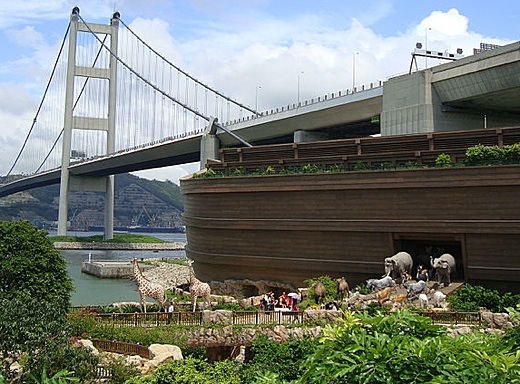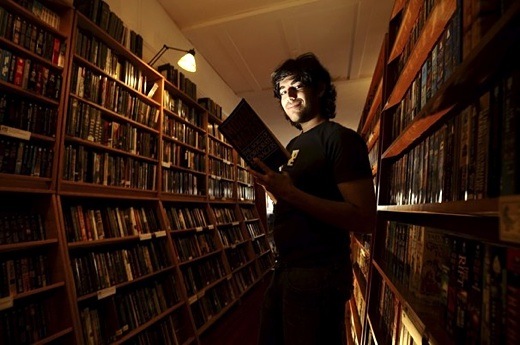SUBHEAD: The more territory has to be governed the more resources will be absorbed in the process of governing.
By John Michael Greer on 30 January 2013 for Archdruid Report -
(
http://thearchdruidreport.blogspot.com/2013/01/we-dont-live-in-neverland.html)
 Image above: Michael Jackson's unbuilt Neverland theme park. From (http://thedisneyblog.com/2010/11/14/michael-jacksons-unbuilt-neverland-theme-park/).
Image above: Michael Jackson's unbuilt Neverland theme park. From (http://thedisneyblog.com/2010/11/14/michael-jacksons-unbuilt-neverland-theme-park/).
The return to an older American concept of government as the guarantor of the national commons, the theme of last week’s post here on
The Archdruid Report, is to my mind one of the crucial steps that might just succeed in making a viable future for the post-imperial United States.
A viable future, mind you, does not mean one in which any significant number of Americans retain any significant fraction of the material abundance we currently get from the “wealth pump” of our global empire.
The delusion that we can still live like citizens of an imperial power when the empire has gone away will be enormously popular, not least among those who currently insist they want nothing to do with the imperial system that guarantees their prosperity, but it’s still a delusion.
The end of American empire, it deserves repeating, means the end of a system in which the five per cent of humanity that live in the United States get to dispose of a quarter of the planet’s energy and a third of its raw materials and industrial product.
Even if the fossil fuels that undergird the industrial product weren’t depleting out of existence—and of course they are—the rebalancing of global wealth driven by the decline of one empire and the rise of another will involve massive and often traumatic impacts, especially for those who have been living high on the hog under the current system and will have to get used to a much smaller portion of the world’s wealth in the years immediately ahead.
Yes, dear reader, if you live in the United States or its inner circle of allies—Canada, Britain, Australia, Japan, and a few others—this means you.
I want to stress this point, because habits of thought already discussed in this sequence of posts make it remarkably difficult for most Americans to think about a future that isn’t either all warm fuzzy or all cold prickly. If an imagined future is supposed to be better than the one we’ve got, according to these habits of thought, it has to be better in every imaginable way, and if it’s worse, it has to be worse just as uniformly.
Suggest that the United States might go hurtling down the far side of its imperial trajectory and come out of the process as a Third World nation, as I’ve done here, and you can count on blank incomprehension or self-righteous anger if you go on to suggest that the nation that comes out the other side of this project might still be able to provide a range of basic social goods to its citizens, and might even recover some of the values it lost a century ago in the course of its headlong rush to empire.
Now in fact I’m going to suggest this, and indeed I’ve already sketched out some of the steps that individual Americans might choose to take to lay the foundations for that project. Still, it’s also worth noting that the same illogic shapes the other end of the spectrum of possible futures.
These days, if you pick up a book offering a vision of a better future or a strategy to get there, it’s usually a safe bet that you can read the thing from cover to cover no reference whatsoever to any downsides, drawbacks, or tradeoffs that might be involved in pursuing the vision or enacting the strategy.
Since every action in the real world has downsides, drawbacks, and tradeoffs, this is not exactly a minor omission, nor does the blithe insistence on ignoring such little details offer any reason to feel confident that the visions and strategies will actually work as advertised.
One example in particular comes to mind here, because it has immediate relevance to the project of this series of posts.
Those of my readers who have been following the peak oil scene for any length of time will have encountered any number of enthusiastic discussions of relocalization: the process, that is, of disconnecting from the vast and extravagant global networks of production, consumption, and control that define so much of industrial society, in order to restore or reinvent local systems that will be more resilient in the face of energy shortages and other disruptions, and provide more security and more autonomy to those who embrace them.
A very good case can be made for this strategy. On the one hand, the extreme centralization of the global economy has become a source of massive vulnerabilities straight across the spectrum from the most abstract realms of high finance right down to the sprawling corporate structures that put food on your table.
Shortfalls of every kind, from grain and fuel to financial capital, are becoming a daily reality for many people around the world as soaring energy costs put a galaxy of direct and indirect pressures on brittle and overextended systems. That’s only going to become worse as petroleum reserves and other vital resources continue to deplete.
As this process continues, ways of getting access to necessities that are deliberately disconnected from the global economic system, and thus less subject to its vulnerabilities, are going to be well worth having in place.
At the same time, participation in the global economy brings with it vulnerabilities of another kind. For anyone who has to depend for their daily survival on the functioning of a vast industrial structure which is not answerable to the average citizen, talk about personal autonomy is little more than a bad joke, and the ability of communities to make their own choices and seek their own futures in such a context is simply another form of wishful thinking.
Many people involved in efforts to relocalize have grasped this, and believe that deliberately standing aside from systems controlled by national governments and multinational corporations offers one of the few options for regaining personal and community autonomy in the face of an increasingly troubled future.
There are more points that can be made in favor of relocalization schemes, and you can find them rehashed endlessly on pro-relocalization websites all over the internet. For our present purposes, though, this fast tour of the upside will do, because each of these arguments comes with its own downside, which by and large you won’t find mentioned anywhere on those same websites.
The downside to the first argument? When you step out of the global economy, you cut yourself off from the imperial wealth pump that provides people in America with the kind of abundance they take for granted, and the lifestyles that are available in the absence of that wealth pump are far more restricted, and far more impoverished, than most would-be relocalizers like to think.
Peasant cultures around the world are by and large cultures of poverty, and there’s a good reason for that: by the time you, your family, and the other people of your village have provided food on the table, thatch on the roof, a few necessary possessions, and enough of the local equivalent of cash to cover payments to the powers that be, whether those happen to be feudal magnates or the local property tax collector, you’ve just accounted for every minute of labor you can squeeze out of a day.
That’s the rock on which the back-to-the-land movement of the Sixties broke; the life of a full-time peasant farmer scratching a living out of the soil is viable, and it may even be rewarding, but it’s not the kind of life that the pampered youth of the Baby Boom era was willing to put up with for more than a fairly brief interval.
It may well be that economic relocalization is still the best available option for dealing with the ongoing unraveling of the industrial economy—in fact, I’d agree that this is the case—but I wonder how many of its proponents have grappled with the fact that what they’re proposing may amount to no more than a way to starve with dignity while many others are starving without it.
The downside to the second argument is subtler, but in some ways even more revealing. The best way to grasp it is to imagine two relocalization projects, one in Massachusetts and the other in South Carolina.
The people in both groups are enthusiastic about the prospect of regaining their personal autonomy from the faceless institutions of a centralized society, and just as eager to to bring back home to their own communities the power to make choices and pursue a better future.
Now ask yourself this: what will these two groups do if they get that power? And what will the people in Massachusetts think about what the people in South Carolina will do once they get that power?
I’ve conducted a modest experiment of sorts along these lines, by reminding relocalization fans in blue states what people in red states are likely to do with the renewed local autonomy the people in the blue states want for themselves, and vice versa. Every so often, to be sure, I run across someone—more often on the red side of the line than on the blue one—whose response amounts to “let ‘em do what they want, so long as they let us do what we want.”
Far more often, though, people on either side are horrified to realize that their opposite numbers on the other side of America’s widening cultural divide would use relocalization to enact their own ideals in their own communities.
More than once, in fact, the response has amounted to a flurry of proposals to hedge relocalization about with restrictions so that it can only be used to support the speaker’s own political and social agendas, with federal bureaucracies hovering over every relocalizing community, ready to pounce on any sign that a community might try to do something that would offend sensibilities in Boston or San Francisco, on the one hand, or the Bible Belt on the other.
You might think, dear reader, that it would be obvious that this would be relocalization in name only; you might also think that it would be just as obvious that those same bureaucracies would fall promptly into the hands of the same economic and political interests that have made the current system as much of a mess as it is.
Permit me to assure you that in my experience, among a certain segment of the people who like to talk about relocalization, these things are apparently not obvious at all.
By this point in the discussion, I suspect most of my readers have come to believe that I’m opposed to relocalization schemes. Quite the contrary, I think they’re among the best options we have, and the fact that they have significant downsides, drawbacks, and tradeoffs does not nullify that.
Every possible strategy, again, has downsides, drawbacks, and tradeoffs; whatever we choose to do to face the onset of the Long Descent, as individuals, as communities, or as a nation, problems are going to ensue and people are going to get hurt.
Trying to find an option that has no downsides simply guarantees that we will do nothing at all; and in that case, equally, problems are going to ensue and people are going to get hurt. That’s how things work in the real world—and it may be worth reminding my readers that we don’t live in Neverland.
Thus I’d like to suggest that a movement toward relocalization is another crucial ingredient of a viable post-imperial America. In point of fact, we’ve got the structures in place to do the thing already; the only thing that’s lacking is a willingness to push back, hard, against certain dubious habits in the US political system that have rendered those structures inoperative.
Back in 1787, when the US constitution was written, the cultural differences between Massachusetts and South Carolina were very nearly as sweeping as they are today.
That’s one of the reasons why the constitution as written left most internal matters in the hands of the individual states, and assigned to the federal government only those functions that concerned the national commons as a whole: war, foreign policy, minting money, interstate trade, postal services, and a few other things.
The list was expanded in a modest way before the rush to empire, so that public health and civil rights, for example, were brought under federal supervision over the course of the 19th century.
Under the theory of government I described last week, these were reasonable extensions, since they permitted the federal government to exercise its function of securing the national commons.
Everything else remained in the hands of the states and the people. In fact, the tenth amendment to the US constitution specifically requires that any power not granted to the federal government in so many words be left to the states and the people—a principle which, perhaps not surprisingly, has been roundly ignored by everyone in Washington DC for most of a century now.
Under the constitution and its first nineteen amendments, in fact, the states were very nearly separate countries who happened to have an army, navy, foreign policy, and postal system in common.
Did that system have problems? You bet. What rights you had and what benefits you could expect as a citizen depended to a huge extent on where you lived—not just which state, but very often which county and which township or city as well. Whole classes of citizens might be deprived of their rights or the protection of the laws by local politicians or the majorities that backed them, and abuses of power were pervasive.
All of that sounds pretty dreadful, until you remember that the centralization of power that came with America’s pursuit of empire didn’t abolish any of those things; it simply moved them to a national level.
Nowadays, serving the interests of the rich and influential at the expense of the public good is the job of the federal government, rather than the local sheriff, and the denial of civil rights and due process that used to be restricted to specific ethnic and economic subgroups within American society now gets applied much more broadly.
Furthermore, one of the things that’s rendered the US government all but incapable of taking any positive action at all in the face of a widening spiral of crises is precisely the insistence, by people in Massachusetts, South Carolina, and the other forty-eight states as well, that their local views and values ought to be the basis of national policy.
The rhetoric that results, in tones variously angry and plaintive, amounts to “Why can’t everyone else be reasonable and do it my way?”—which is not a good basis for the spirit of compromise necessary to the functioning of democracy, though it makes life easy for advocacy groups who want to shake down the citizenry for another round of donations to pay for the never-ending fight.
One of the few things that might succeed in unsticking the gridlock, so that the federal government could get back to doing the job it’s supposed to do, would be to let the people in Massachusetts, South Carolina, and the other forty-eight states pursue the social policies they prefer on a state by state basis.
Yes, that would mean that people in South Carolina would do things that outraged the people in Massachusetts, and people in Massachusetts would return the favor. Yes, it would also mean that abuses and injustices would take place.
Of course abuses and injustices take place now, in both states and all the others as well, but the ones that would take place in the wake of a transfer of power over social issues back to the states would no doubt be at least a little different from the current ones.
Again, the point of relocalization schemes is not that they will solve every problem. They won’t, and in fact they will certainly cause new problems we don’t have yet. The point of relocalization schemes is that, all things considered, if they’re pursued intelligently, the problems that they will probably solve are arguably at least a little worse than the problems that they will probably cause. Does that sound like faint praise?
It’s not; it’s as much as can be expected for any policy this side of Neverland, in the real world, where every solution brings new problems of its own.
Now in fact relocalization has at least two other benefits that tip the balance well into positive territory. One of them is an effect I haven’t discussed in this series of posts, and I haven’t seen covered anywhere else in the peak oil blogosphere yet; it will need a post of its own, and that will have to wait a week. The other, though, is a simple matter of resilience.
The more territory has to be governed from a single political center, all things considered, the more energy and resources will be absorbed in the process of governing. This is why, before the coming of the industrial age, nations on the scale of the present United States of America rarely existed, and when they did come into being, they generally didn’t last for more than a short time.
In an age of declining energy availability and depleting resources, the maintenance costs of today’s sprawling, centralized United States government won’t be affordable for long.
Devolving all nonessential functions of the central government to the individual states, as the US constitution mandates, might just cut costs to the point that some semblance of civil peace and democratic governance can hang on for the long term.
.












